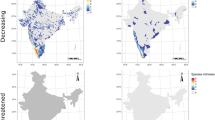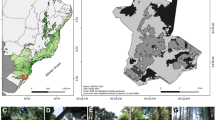Summary
Fruit and seed set was studied in New Zealand flax (Phormium tenax Phormiaceae) a large monocot that preferentially sets outcrossed seeds. Fruit set was low and in particular situations could result from insufficient pollinator visitation. Observations of pollinator (Meliphagidae) movements showed that birds preferentially visited male phase flowers and predominantly moved pollen within inflorescences of the same plant. More dominant ‘resident’ birds moved more between plants that subordinate ‘non-resident’ birds. Combination of results of fluorescent dye carryover with known bird movements allowed predictions of fruit set and seed size that closely approximated observed levels. Resident birds account for almost half the observed foraging bouts but are predicted to be responsible for the vast majority of the viable seeds.
Similar content being viewed by others
References
bell G, Lefebvre L, Giraldeau LA, Weary D (1984) Partial preference of insects for male flowers of an annual herb. Oecologia 64:287–294
Bertin RI (1985) Nonrandom fruit production in Campsis radicans: between-year consistancy and effects of prior pollination. Am Nat 126:750–759
Bowman RN (1987) Cryptic self-incompatibility and the breeding system of Clarkia unguniculata (Onagraceae). Am J Bot 74:471–476
Casper BB (1984) On the evolution of embryo abortion in the herbaceous perennial Cryptantha flava. Evolution 38:1337–1349
Craig JL (1989) A differential response to self-pollination: seed size in Phormium. NZ J Bot 27 (in press)
Craig JL, Stewart AM (1989) Reproductive biology of Phormium tenax: a honeyeater pollinated species. NZ J Bot 26:453–463
Guth CJ, Weller SG (1986) Pollination, fertilization and ovule abortion in Oxalis magnifica. Am J Bot 73:246–253
Hainsworth FR, Wolf LL, Mercier T (1985) Pollen limitation in a monocarpic species, Ipomopsis aggregata. J Ecol 73:263–270
Levin DA (1984) Inbreeding depression and proximity-dependent crossing success in Phlox drummondii. Evolution 38:116–127
McDade LA (1985) Breeding systems of central American Aphelandra (Acanthaceae). Am J Bot 72:1515–1521
McDade LA, Davidar P (1984) Determinants of fruit and seed set in Pavonia dasypetala (Malvaceae). Oecologia 64:61–67
Marshall DL, Ellstrand NC (1985) Proximal canses off multiple paternity in wild radish, Raphanus sativus. Am Nat 126:596–605
Mazer SJ, Snow AA, Stanton ML (1986) Fertilization dynamics and parental effects upon fruit development in Raphanus raphanistrum: consequences for seed size variation. Am J Bot 73:500–511
Murawski DA, Gilbert LE (1986) Pollen flow in Psiguria warscewiczii: a comparison of Heliconius butterflies and hummingbirds. Oecologia 68:161–167
Nybom H (1987) Pollen-limited seed set in pseudogamous blackberries (Rubus L. subgen. Rubus). Oecologia 72:562–568
Price MV, Waser NM (1979) Pollen dispersal and optimal outcrossing in Delphinium nelsoni. Nature 277:294–296
Queller DC (1985) Proximate and ultimate causes of low fruit production in Ascepias exalta. Oikos 44:373–381
Sayers ER, Murphy RP (1966) Seed set in alfalfa as related to pollen tube growth fertilization frequency, and post-fertilization ovule abortion. Crop Sci 6:365–368
Schmitt J (1983) Density dependent pollinator foraging, flowering phenology, and temporal pollen dispersal patterns in Linanthus bicolor. Evolution 37:1247–1257
Snow AA (1986) Pollination dynamics in Epilobium canum (Onograceae): consequences for gametophytic selection. Am J Bot 73:139–151
Stephenson AG (1981) Flower and fruit abortion: proximate causes and ultimate functions. Ann Rev Ecol Syst 12:253–279
Stephenson AG, Bertin (1983) Male competition, female choice, and sexual selection in plants. In: Real L (ed) Pollination biology. Academic Press, New York, pp 110–151
Sutherland S (1986) Floral sex ratios, fruit set, and resource allocation in plants. Ecology 67:991–1001
Sutherland S (1986) Patterns of fruit set: what controls fruit flower ratios in plants. Evolution 40:117–128
Temme DH (1986) Seed size variability: a consequence of variable genetic quality among offspring? Evolution 40:414–417
Waser NM (1982) A comparison of distances flown by different visitors to flowers of the same species. Oecologia 55:251–257
Waser NM, Price MV (1982) A comparison of pollen and fluorescent dye carry-over by natural pollinators of Impomopsis aggregata (Polemoniaceae). Ecology 63:1168–1172
Waser NM, Price MV (1983) Optimal and actual outcrossing in plants, and the nature of plant-pollinator interaction. In: Jones CE, Little RJ (eds) Handbook of experimental pollination biology. van Nostrand Reinhold, New York, pp 341–359
Webb CJ, Bawa KS (1983) Pollen dispersal by hummingbirds and butterflies: a comparative study of two lowland populations. Evolution 37:1258–1270
Willson MF, Burley N (1983) Mate choice in plants: tactics, mechanisms, and consequences. Princeton University Press, Princeton
Windsor JA, Davis LE, Stephenson AG (1987) The relationship between pollen load and fruit maturation and the effect of pollen load on offspring vigor in Cucurbita pepo. Am Nat 129:643–656
Wolf LL, Hainsworth FR, Mercier T, Benjamin R (1986) Seed size variation and pollinator uncertainty in Ipomopsis aggregata (Polemoniaciae). J Ecol 74:361–371
Author information
Authors and Affiliations
Rights and permissions
About this article
Cite this article
Craig, J.L. Seed set in Phormium: interactive effects of pollinator behaviour, pollen carryover and pollen source. Oecologia 81, 1–5 (1989). https://doi.org/10.1007/BF00377001
Received:
Accepted:
Issue Date:
DOI: https://doi.org/10.1007/BF00377001




